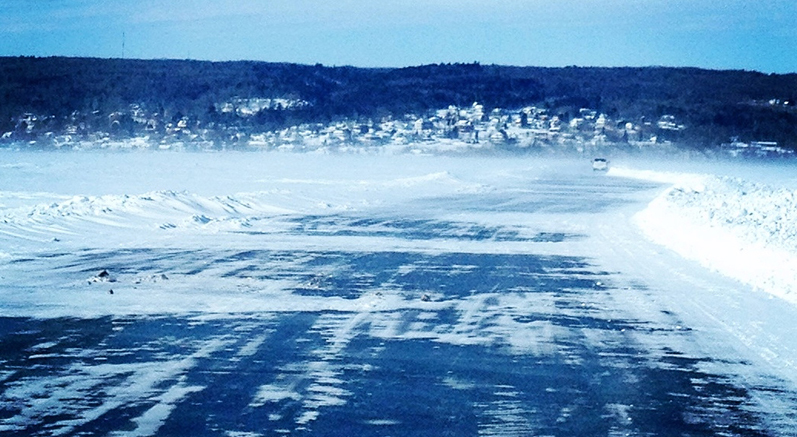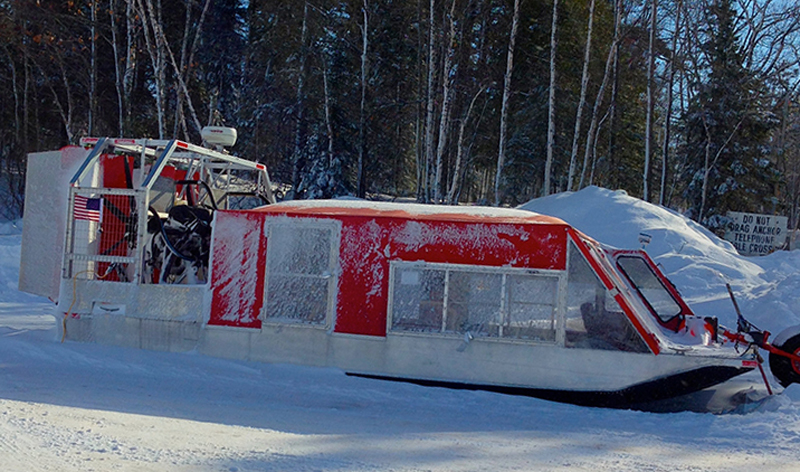
The whiteness all around is blinding. Windswept snow smudges the very horizon, blurring frozen shoreline with frozen skyline. Few places I’ve known felt this barren, this lonely. But in the attempt to capture it all on camera with numbed fingers, I must suddenly leap backwards to avoid a pickup truck.
I’m standing on Lake Superior, and I’ve almost been hit by a car.
The driver rolls her eyes as she passes, as if to say, “What are you doing — it’s rush hour!”

Forbidding as it looks, the naturally-forming ice road between Bayfield, Wisconsin, and Madeline Island is anything but desolate — it’s a lifeline.
During warmer months, a regular ferry crosses the roughly 2 1/2 mile stretch of water. Its passengers are largely vacationers to the island, the largest of the National Park System’s Apostle Islands. Yet for the 246 year-round residents, daily life is at the mercy of that schedule. If a movie in town runs later than the last boat, you don’t see the movie. And commuters five minutes late at the ferry will just have to wait for the next one.

Ironically, the truer sense of freedom and connection with “the rest of the world” arrives in winter when the ice is thick enough to allow islanders to drive snowmobiles, cars and small trucks across whenever they want. And in this near-record year for ice cover on the Great Lakes, it was indeed well-traveled.
The Madeline Island ice road is recognized by the government and designated as an extension of Wisconsin County Highway H. That means that all traffic rules apply, including staying on the marked road and following the hand-painted signs.
It is monitored when open, with updates posted regularly.
With up to six lanes of traffic, the ice road becomes a veritable freeway for locals (add to that, the occasional car-full of agog tourists). And as with any roadway, safety precautions prevail: Small pine trees are placed as lane markers along the route, directing them to the landings on either end. Traffic signs, sometimes hand-painted, abound and often overheard are verbal warnings against driving over 25mph (speed can create waves turbulent enough to jeopardize even 18-plus inches of ice cover).

By far, the most notable sight on the ice road is the otherworldly fleet of windsleds. They may draw quick comparisons to vehicles out of Star Wars, but their purpose is a bit more grounded in reality. During those “in between” weeks when the ice is too thin and the slush too thick for cars, the three windsleds are the most reliable way to the mainland.

These fan-powered craft (the largest able to carry 22 passengers) roar to life with the noise of an airplane, ferrying both school kids and errand-runners alike. They’ll often share the space with daily mail and deliveries for the island’s shopkeepers.
The windsled drivers assume a unique responsibility, not only requiring them to make quick judgment calls with safe operation, but also stay in tune with individual residents’ needs for possible emergency transport.

With all the unique sights, it may be easy for the visitor to see the Madeline Island ice road as something of a quaint destination. Maybe even as a hub for local gatherings. But for those who rely on the gelid path and the windsled drivers who navigate it, the ice road is more than that; it’s a bridge connecting their lives on the island to life here on the mainland.

—When not breathing life into pixels as a User Interaction Designer, Andy Wright is recharging his soul in the wilds of Northern Minnesota and Wisconsin. Conscientiously avoiding the label “avid outdoorsman” – because everyone reading this calls themselves that – he especially enjoys canoe camping, snowshoeing and stand-up paddle boarding. But he does do these things avidly.





